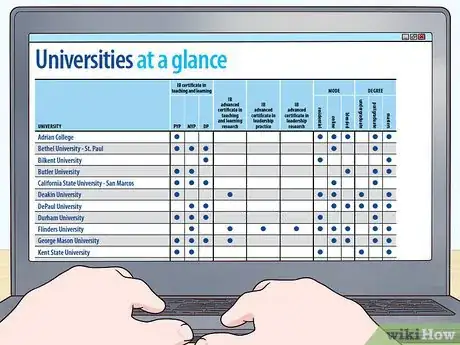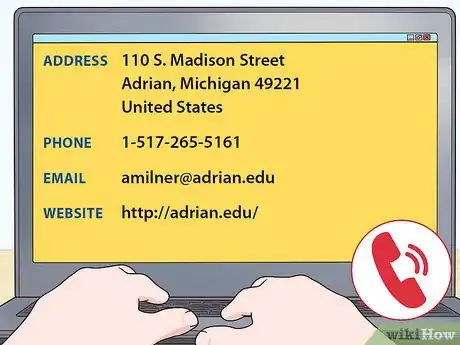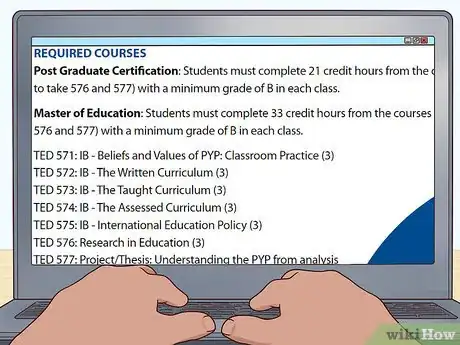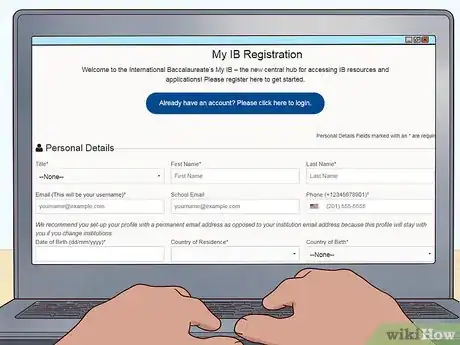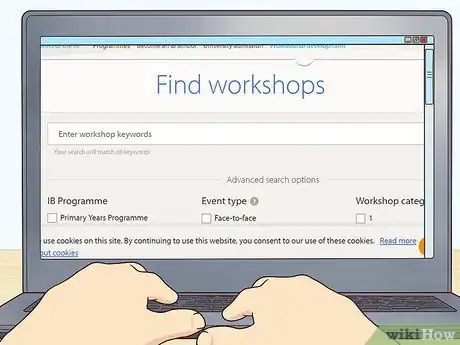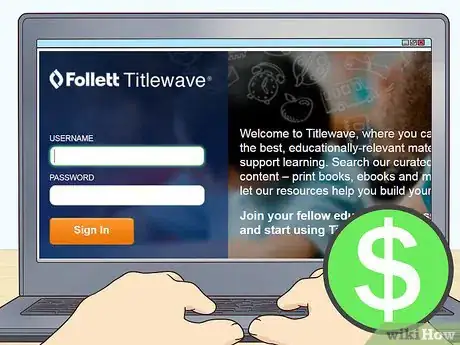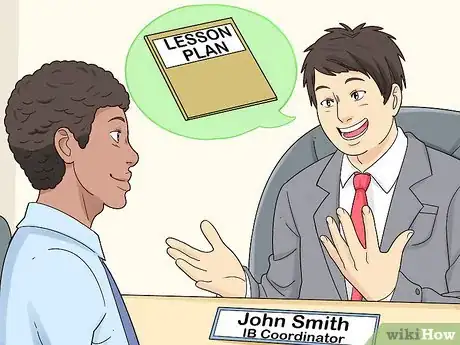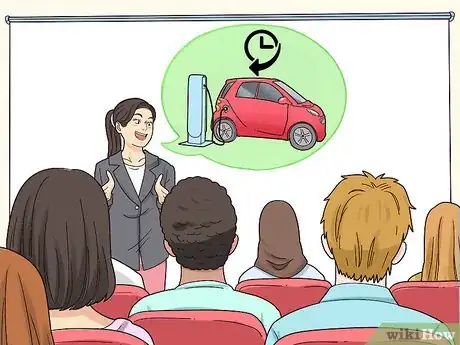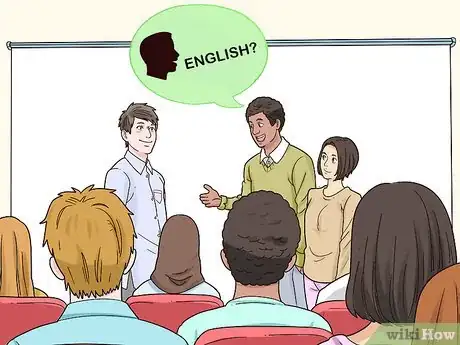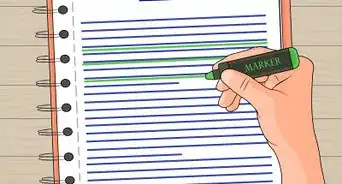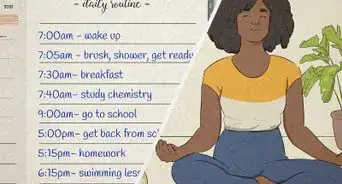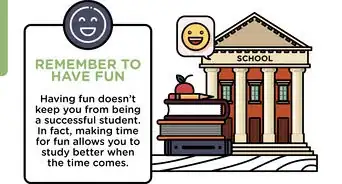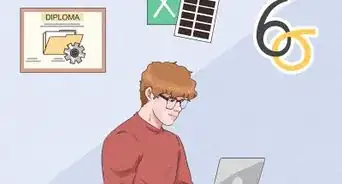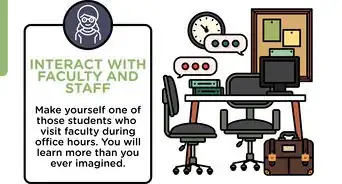This article was co-authored by wikiHow Staff. Our trained team of editors and researchers validate articles for accuracy and comprehensiveness. wikiHow's Content Management Team carefully monitors the work from our editorial staff to ensure that each article is backed by trusted research and meets our high quality standards.
There are 7 references cited in this article, which can be found at the bottom of the page.
This article has been viewed 27,666 times.
Learn more...
The International Baccalaureate (IB) is a non-profit educational program that focuses on a global view of the world. It offer 4 programmes covering the education of high achieving students aged 3-19. To teach IB classes, you can pursue IB certification and access the IB’s many teaching resources.
Steps
Earning an IB Educator Certificate
-
1Find an IB educator certificate program near you. Though any qualified educators can technically teach IB classes, teachers with an IB background will have a leg up when applying to teach at IB schools. Find a university or educational institution near you offering an IB educator certificate program. You can also sign up for online courses to get a certificate remotely.
- Visit the International Baccalaureate website at http://ibo.org/globalassets/professional-development/ib-university-directory-2017-en.pdf to get a listing of the universities offering IB educator certificates, as well as detailed outline of what each specific program entails.
- On average, IB certification takes about 22 weeks to complete.[1]
-
2Make sure you meet the entry qualifications for the program. Each educational institution offering an IB educator program has its own entry requirements. You can look up these requirements on the IB directory, or on your program's website.
- To look up the requirements in the IB educator certificates directory go to: http://ibo.org/globalassets/professional-development/ib-university-directory-2017-en.pdf.
- If you do not meet the requirements, look into the requirements for other certificate programs offered online or in your area.
Advertisement -
3Contact the institution to ask about their fee structure. The costs associated with getting an IB educator certificate will depend on the unique fee structure of the institution offering it. This may vary greatly depending on the country the institution is located in. Contact the institution of your choice before applying to get this information.
-
4Choose the focus of your program before applying. The IB offers 4 keys programmes targeting different ages and educational goals. Choose the aim of your certificate training based on your teaching concentration. For instance: [2]
- If you want to teach IB classes in an elementary school, choose the Primary Years programme, geared for children aged 3-12.
- If your goal is to teach IB classed to middle school students, opt for the Middle Years programme, focusing on children aged 11-16.
- If your career goal is to teach IB classes to older high school students, choose the Diploma program focusing on academically-focused students aged 16-19.
- You can also decide to study the Career-related programme, which focuses on more career-specific education for ages 16-19.
-
5Complete the required number of courses to get your certificate. Whether you take courses in person or online, you will have to pass them all to get your certificate. Some institutions will require a minimum grade for each course, and some will set a time limit on how long you can take to complete all the credits. Find out your school's specific requirements to ensure that you obtain your certificate.
Using IB Teaching Resources
-
1Register to access the IB's hub for teaching resources. As an IB educator you have the right access a portal granting you resources, learning apps, and communities for each IB programme. Once your online registration is approved, you can sign up for resources for a number of different subjects within your particular IB programme. For instance, if you teach a variety of subjects within the middle years programme, you can access resources for each of them.
- If you teach IB classes in more than one programme, you will have to register more than once.
- Visit https://internationalbaccalaureate.force.com/ibportal/IBPortalRegistration to complete your registration.
-
2Attend an IB workshop online or in person for lesson plan inspiration. Workshops focusing on each of the 4 IB programmes may offer you guidance about how to teach classes and structure your lesson plans. These events will let you network and interact with other IB educators.Find workshops through the IB website and register online.
- Visit the IB website at http://www.ibo.org/professional-development/find-events-and-workshops/ to look up workshops being held in your area, or online.
- Search by country, date, programme, and language of delivery.
-
3Follow IB news and trends on social media. The IB has both Twitter and Facebook accounts through which teachers can interact and share ideas. These platforms are also a good way to stay up to date on new developments in the IB curriculum and upcoming events. Use these social media resources to network with other IB educators from far and near.
- Find the IB’s Twitter page at https://twitter.com/iborganization.
- Find its Facebook page at https://www.facebook.com/IBO.org.
-
4Purchase IB-specific teaching materials. The IB program offers a selection of approved learning materials, available through the Follett Titlewave educational store. You can find IB resources such as printed textbooks, eText documents, and videos. Visit https://www.titlewave.com/go/ib to set up an account and start shopping.
-
5Meet with your school's IB coordinator for lesson planning advice. An IB coordinator is a teacher or administrator who is responsible for the school's implementation of the IB programme. Their duties include meeting with teachers to discuss lesson plans, keeping parents and the school principal informed about the program, and handling the program's administration.[3]
- You may need to schedule time outside of classes to meet with your school's IB coordinator for help developing your teaching plan.
Framing IB Lessons
-
1Ask students to examine issues across disciplines. The IB program is unique in that it does not separate study strictly between academic subjects. Encourage your students to think about important issues in the context of different subjects like history, science, and literature. Ask them to make connections between seemingly disparate ideas to demonstrate how things are interconnected.[4]
- For example, have students learn about electric cars and study the history of their invention, scientific origins, and social importance.
-
2Encourage students to ask questions in all subjects. Critical thinking is a crucial component of the IB philosophy of learning. Encourage your students to question issues and concepts in every possible subject, without pushing simple answers. Prompt debate about critical global issues to further the notion that multiple ideas about the same topic can be right.[5]
- For instance, when approaching a classic piece of literature, have students debate why we still read in as part of a regular English curriculum.
-
3Have students plan and outline their own projects. The IB program promotes learning without strict parameters. Students benefit from exploring their interests and strengths and devising the specific details of their academic endeavors, including a major personal project at the end of their IB schooling in the Diploma programme. Give students open-ended assignments that require them to choose topics that they deem significant, in the manner they see fit.[6]
- For instance, a student may choose to film a documentary about recycling initiatives in the school and relate it to greater environmental trends.
-
4Create collaboration teams with other teachers at your school. Partnering with other IB educators at your school is a great way to relieve stress, drum up energy, and co-plan lessons. Share lesson plans in face-to-face meetings or virtually on a shared drive, such as Google Drive. Team up with teachers who are teaching the same grades or subjects as you to develop in-class projects, assignments, and lessons to engage your students.[7]
-
5Prepare lessons for SL and HL courses in the IB Diploma programme. In the IB Diploma Programme, students must take at least 3 courses at a higher level (HL) instead of the regular standard level (SL). SL courses should consist of approximately 150 hours of instructional time, while HL classes should be at least 240 hours. Prepare additional lesson plans and projects for HL course loads that will be more challenging than the SL content.[8]
References
- ↑ https://education.depaul.edu/about/centers-and-initiatives/innovative-professional-learning/Pages/ib-educator-certificate.aspx
- ↑ https://www.ibo.org/en/programmes/
- ↑ https://www.aft.org/periodical/american-educator/summer-2002/test-worth-teaching/
- ↑ https://xqsuperschool.org/rethinktogether/interdisciplinary-teaching-and-learning/
- ↑ https://www.greatschools.org/gk/articles/what-is-ib-international-baccalaureate/
- ↑ https://www.greatschools.org/gk/articles/what-is-ib-international-baccalaureate/
- ↑ https://www.edutopia.org/practice/teacher-collaboration-matching-complementary-strengths
- ↑ https://www.ibo.org/university-admission/support-students-transition-to-higher-education/course-selection-guidance/
